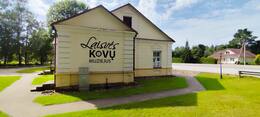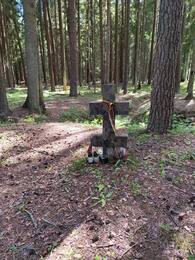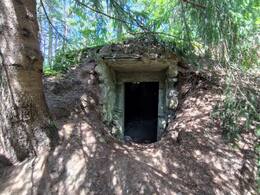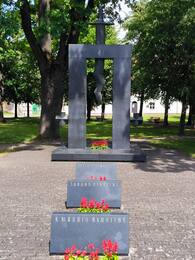Partisan Roads and Trails in Aukštaitija
Day 1.
115 km
Utena – Visetiskes – Andrioniskis – Troskunai – Panevėžys
Practical info
- The itinerary is intended as a guide - how to optimally travel a region or country, or two countries, with the aim of getting to know their military heritage;
- The driver must plan for himself - how many of the recommended objects and places he can explore in one day;
- Before traveling, you should check the opening hours of sightseeing places (museums, collections, fortifications, etc.);
- In places where advance registration is required (local guides, private collections, other), a visit must be booked, specifying the date and time. If the trip is canceled, the registered places must be informed;
- Accommodation must be booked in advance. Accommodation may be unavailable during the summer season, especially on the coast. Some catering establishments may not be open during the winter season;
- Choose not only summer for your trip, but also other seasons;
- The Latvian-Lithuanian-Estonian borders can be crossed by road freely without restrictions and at any time of the day. When entering from one country to another, you must have an ID card or passport with you;
- Visit tourist information centers where you can get additional information, brochures, and maps.
Sights
Museum of the Battles for Freedom in Utena
The museum is located in Utena, near the junction of the Kaunas-Daugpilis (A6) and Vilnius-Utena (A14) trunk roads. The museum was established in 2015 at the former narrow gauge railway station building of Utena. The museum claims to be a form of poetry that tacitly exposes the post-war truth. The exhibition “A Common European Identity in the Context of Totalitarian Regimes” offers to explore the past of Lithuania and Europe through the history of one Lithuanian region. It tells the story of secret documents and the division of Europe in 1939, the Soviet occupation of Lithuania, the forced participation of Lithuanians in World War II, exile, post-war resistance and the organisation of collective farms in the Utena region. The painful events of 1940–1965 in the Utena region and the events in Lithuania are contrasted with life behind the Iron Curtain. The history of the narrow-gauge railway station also has tragic pages. From here, in 1941 and from 1945–1953, train cars with deportees were sent to Siberia.
Along the Trails of the Partisan Battles of the Algimantas Military District
Located in Šimonys Forest, along road No. 1216 (a sign and a stand have been installed). Šimonys Forest was known in the post-war Lithuanian partisan struggle as the centre of activity of the largest partisan unit in Aukštaitija, the Algimantas military district. Approximately 200 partisans were operating in the area in 1945, while by 1952, there were only 20–30. From 1947 to 1949, the Šimonys Forest was used by the commander of the East Lithuania (King Mindaugas) partisan territory, Captain Jonas Kimštas-Žalgiris, and in 1949, by the commander who took over from him, Antanas Starkus–Montė, as hiding places – command posts from which the partisan movement in Aukštaitija was coordinated. The route of the partisan battles of the Algimantas military district invites you to get acquainted with six partisan hideouts of the Algimantas military district, created by the partisans of the Žalioji, Šarūnas and Kunigaikštis Márgiris (King Márgiris) units, who hid and fought here. There are two walking routes of different lengths (5 and 10 km) in Šimonys Forest, which invite you to follow the paths of the partisans.
Eastern Lithuania (King Mindaugas) region Lithuanian partisan command post
After driving past Andrioniškis Cemetery (there is a signpost), there is a preserved hideout – a command post. From 1944– 1949, a command post of the Lithuanian partisans of the Eastern Lithuania (King Mindaugas) region operated in this hiding place. In the summer of 1944, Balys Žukauskas, with brothers Petras and Juozas Jovaišos, established the hiding place to evade the mobilisation announced by the Red Army in 1944. At the end of 1945, Antanas Slučka-Šarūnas started to use the hiding place. He was the first one to form a partisan unit in the Troškūnai area and later united the partisans of Rokiškis, Anykščiai, Kavarskas, Troškūnai, and Andrioniškis to form the Šarūnas Unit. In 1947, A. SlučkaŠarūnas became the commander of the Algimantas district, and in 1949 – the commander of the Eastern Lithuania partisan region. This means that from 1949, the hiding place became the command post of the Lithuanian partisans in the Eastern Lithuania region. The hiding place, which had successfully sheltered partisans for five years, was betrayed on 28 October 1949. The farm where the partisans were hiding was besieged by KGB troops; the partisans refused to surrender and blew themselves up.
The bunker has been preserved, and a cross and a monument to the fallen have been installed.
Monument dedicated to Algimantas Military District partisans
The monument is located in the centre of Troškūnai, Anykščiai district, near the Church of Holy Trinity. During the partisan war of 1944–1953, the territory of Lithuania was divided into nine partisan military regions. From 1947–1950, partisan units of the Algimantas region of Lithuania, the establishment of which is closely related to Troškūnai, were active in the Panevėžys and Anykščiai area. The inhabitants of this town organised partisan units in Aukštaitija. The first partisan commander of the Algimantas region, Antanas Slučka-Šarūnas, was born and lived in Troškūnai.
In 1996, pursuant to the initiative of the Genocide and Resistance Research Centre of Lithuania, a monument dedicated to the partisans of the Algimantas Military District was erected in Troškūnai. The monument was created by sculptor Jonas Jagėla and architect Audronė Kiaušinienė. The main part of the monument is a black stone gate that symbolises the fallen defenders of the homeland. The bronze crosses on the sides of the gate symbolise the Christian faith, while the bronze sword, like the sword of St Michael the Archangel, symbolises the light of faith and hope. In the square in front of the monument, a black stone plaque commemorates the three units of the Algimantas region: Šarūnas, Žalioji and Kunigaikštis Márgiris.
Places to eat
- Utena, see www.utenainfo.lt
- Anykščiai, see www.infoanyksciai.lt
- Panevėžys, see www.panevezysnow.lt/turizmas
Places to stay
- Utena, see www.utenainfo.lt
- Anykščiai, see www.infoanyksciai.lt
- Panevėžys, see www.panevezysnow.lt/turizmas







